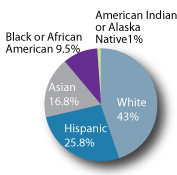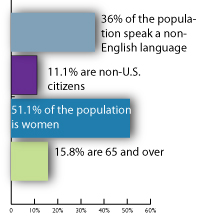Increasing Diversity in Contra Costa County’s Legal Community: A Pragmatic Approach
 Promoting and retaining diverse individuals and firms to join the ranks in Contra Costa County is the goal of the Diversity and Inclusion Initiative, and the Diversity Committee of the Contra Costa County Bar Association.
Promoting and retaining diverse individuals and firms to join the ranks in Contra Costa County is the goal of the Diversity and Inclusion Initiative, and the Diversity Committee of the Contra Costa County Bar Association.
Why should firms care about increasing diversity? The answer is two-fold: it results in better representation for all the citizens of Contra Costa County and there should be financial and additional advantages for the practice. In our quest to diversify, though, some questions come to mind: How much should a firm diversify, and what does that even mean? Does diversifying only mean hiring more diverse attorneys and staff? What other ways can we increase diversity? Espousing diversity without implementation is meaningless, and the aim of this article is to offer some pragmatic suggestions for an approach to increasing diversity that is focused on inclusion.
How diverse is Contra Costa County?
Contra Costa County is becoming increasingly more diverse. The last Census was in 2010, and data from that census revealed a population that was:

- 43% White
- 25.88% Hispanic
- 16.8% Asian
- 9.5% Black or African American
- 1% American Indian or Alaska Native
As we know, though, diversity means more than ethnicity, and the 2010 Census further reveals that:

- 36% of the population speak a non-English language
- 11% are non-U.S. Citizens
- 51.1% of the population are women and
- 15.8% are 65 and over1
The 2020 census should reveal even more about our county, including the number of veterans, people with disabilities and income level, although that data will not likely be available for about two years.
So what does this data tell us about our county and how can we use this to better serve our clients? Firms can use this data to begin to formulate strategies to identify and better serve underrepresented segments. This data is not the beginning and end of that work, however, because simply knowing someone’s broad ethnic category does not in and of itself tell you what you need to know to best serve them. For instance, knowing that a person is of Asian ethnicity does not tell you whether they are Indian, Chinese, Filipino or Japanese – all of which have very different cultural backgrounds and expectations. Even knowing someone’s specific ethnicity is not enough. For instance, a person who is a third or fourth generation citizen may have little in common with someone of the same ethnicity who has newly emigrated.
This also does not mean that the make up of every firm should necessarily mirror the diversity spectrum of the community. It is human nature to feel more at ease with people who share commonalities, but these common elements should transcend ethnic heritage or cultural background. Having a face that’s similar or speaking the same language may bring some comfort or reduce barriers, but it does not substitute for capability. Diversity should not be approached as a trait but as a skill, and skills can be developed or enhanced.
How can a firm expand its diversity to better serve its clients?
Every firm should do a self-assessment that measures the firm’s diversity metrics, both internally and with regard to its client base. This will establish a baseline of the firm’s diversity. Measurements of diversity within the firm could include differences in ethnicities, culture, religions, gender, geography, experience, education, or any other parameters that relate to specific practice areas or client bases.
This material should be obtained and handled with strict privacy considerations, of course.
The firm should also measure the diversity of their clientele. Does the aggregate clientele reflect the diversity of the country? The client metrics will give a 10,000 foot view of the range and types of clients that the firm is attracting – and perhaps just as importantly, not attracting. Evaluations of this type could reveal that the firm is missing significant opportunities as well as neglecting legal needs of a large percentage of the population. Digging deeper into why certain populations are not being represented could reveal that perhaps the firm is seen as unfriendly to certain segments of the community, either because it does not do outreach or because it does not have the resources to accommodate those populations (access to native speakers, for example).
As businesses have learned, if a firm does not have a strategy to attract particular clients, then the de facto strategy can become self-reinforcing. For example, the legal community is heavily driven by referrals, so it can be expected that one client might bring in other similar clients as word spreads. That is, in fact, the hope – that one satisfied client leads to many satisfied clients. However, if your clients are bringing in more clients just like them, then there is no specific outreach to other types of clients, and over time a firm may have a sizeable number of clients from one demographic, giving the appearance that the firm is only focused on a certain demographic. Now, if the goal is to specialize in a particular practice area, that is a good thing, but if it results in a client base that becomes exclusionary on basis other than practice area (e.g., race, gender, ethnicity) then it becomes a problem to be remedied, as well as a potential new source of revenues when new clients are brought into the firm.
How can you improve a firm’s diversity quotient?
Learn whether the client has culture-specificity issues. This approach is more meaningful with newer first or second-generation immigrants. The word Asian is used to classify ethnicity. It is too broad and generic to be informative or helpful. A Southeast Asian may have very little in common with a Northern Asian or one whose ancestry is along the Silk Road. Just in China alone, there are 56 distinct ethnic groups. Although Mandarin is the dominant and state language, there are 297 living languages in China.2 To refer to a client as Asian without understanding more of their culturally specific identity is to do the bare minimum in acknowledging their ethnicity and is a missed opportunity to better serve your client. To understand the different shades of cultural specificity, the best approach is to develop good relationships with your clients and really pay attention to the cultural differences at play. Educate yourself about their background so that you may always serve them in a way that is respectful and will be well received. A little bit of focused effort can go a long way here.
Communication is key in dealing with a diverse clientele, especially if someone is an “English as a Second Language” client. It is important to always consider their level of fluency, the size and breadth of their vocabulary and their level of comfort in letting you know whether they are understanding something. It is important to be aware that someone might not be understanding what you are telling them, but they also may not want to tell you that because they are embarrassed. If you have done an evaluation of your firm’s diversity metrics, you may know that you have someone on staff that can assist with different languages, and you can pull in those resources when necessary. Even when speaking in English, however, it is important not to assume that you and your client are understanding things in the same way. Words may have different connotations in different cultures. Even something as seemingly simple as the word “Yes” may mean different things. In some, it means, “I acknowledge that I heard and understood you,” and in others, it means, “I understand and agree with what you said.”
Remember that non-verbal communication is often heavily used in other cultures, and this goes back to educating yourself about your client’s culture. For example, East Indians have a variety of head motions to indicate no, maybe, yes, hello, and thank you. Using the left hand to give things is improper in some cultures.
Hiring diverse attorneys and staff
The most common, and most obvious, method of reaching out to different groups is to hire attorneys that are more knowledgeable about cultural, language and gender specific issues. The challenge in this approach is that the population of attorneys from diverse backgrounds is more limited, although that has been slowly changing. The California Bar reports that the percentage of women attorneys is now at 42%3 , an increase of 11% over the last decade. The numbers for Hispanic and Black attorneys for 2017 stood at 5% each and Asian attorneys at 2%. This means that while progress has been made, there is still a shortage of diverse attorneys compared to the numbers in the general population, so diversity through hiring has limitations.
One method of outreach is to hold an open house with a segment target community. Often if that segment of the population is large, they will have some organized social or cultural presence. Reach out and begin a dialogue.
What’s the strategic objective of the firm?
Inherent in determining the firm’s diversity goals is knowing what its objectives are and why it wants to achieve certain diversity metrics. Not every firm needs to accurately reflect the diversity of the county, and it has to make financial sense unless the firm is willing to devote resources as part of its community outreach or pro bono services. So, for instance, a firm’s strategic objective may be to serve a certain segment of the population it has identified as a viable market, and in doing so, it may enrich the community even if by itself, the firm has a lack of diversity in its attorney ranks.
Diversity through Inclusion
The goal of diversity is to accept and acknowledge our differences, be they ethnic, religious, gender, value sets, or experiential. We have made great strides in improving the diversity of firms through hiring practices, but we can do more. We can improve diversity by focusing not on exclusion (i.e., by seeing people as “others”) but on inclusive practices, every day, by improving our communication skills, building relationships and learning about each other and our clients. Taking these steps will strengthen our understanding of each other and continue the momentum. We acknowledge our uniqueness and differences and still celebrate our commonality.
[1] https://www.census.gov/quickfacts/contracostacountycalifornia
[2] https://www.worldatlas.com/articles/what-languages-are-spoken-in-china.html
[3] http://www.calbar.ca.gov/Portals/0/documents/Advancing-Diversity-and-Inclusion-in-the-Legal-Profession.pdf